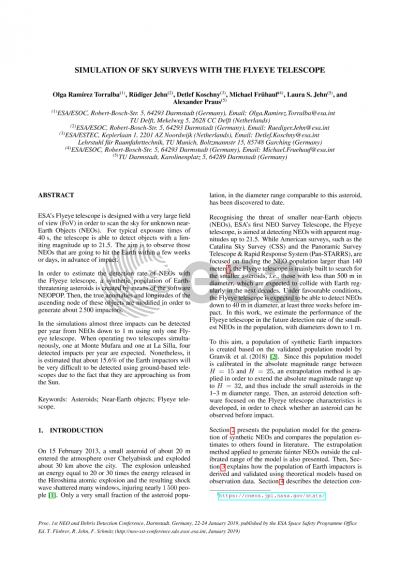Document details

Abstract
ESA is currently building a large field-of-view telescope to scan the sky for unknown Near-Earth Objects (NEOs). The photons that reach the 1.15 m primary mirror are deflected from a beam splitter into 16 CCD cameras. As a result a field-of-view of 6.7 deg by 6.7 deg will be covered at each exposure. For typical exposure times of 40 sec, the limiting magnitude will be around 21.5 mag. The first telescope is planned to be deployed on Monte Mufara in Sicily, Italy and a second telescope in Chile.
With the software NEOPOP a synthetic population of Earth threatening asteroids was created. The true anomalies of the asteroids were modified in order to generate more than 1000 impacts during the simulation period of 1 year. P. Kollo's strategy for the sky survey is applied. In this strategy, each field in the sky is revisited 4 times allowing the asteroids to move at least a few pixels. The sequence of the fields is optimised with respect to telescope slew rate and angular distance to the Sun and Moon. Almost a full hemisphere can be scanned in two nights. Each virtual asteroid is propagated for one year and the Python software checks if it crosses the field-of-view of the camera and if it is bright enough to be detected. The following key questions shall be answered:
• How many impacts will the telescope predict per year?
• How many impacts as function of size will remain undetected?
• What is the influence of the telescope location?
• How does the survey complement existing (e.g. Catalina and Pan-STARRS) or planned (LSST) surveys?
Because the motion of the asteroids is completely independent of each other, parallel programming techniques will be applied to allow the simulation of a large number of asteroids with a small propagation step size. It is expected that the fly-eye telescope will contribute enormously to the future detection rate of NEOs.
Preview


